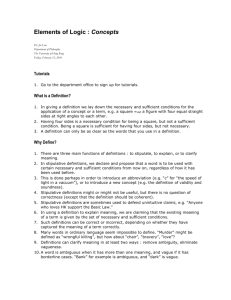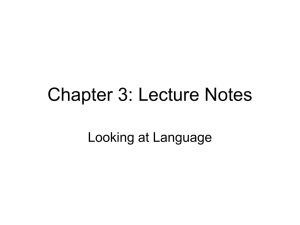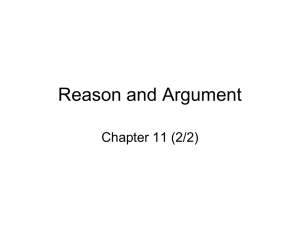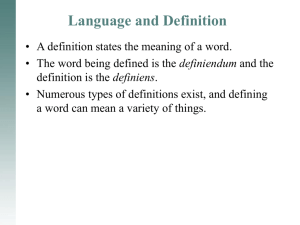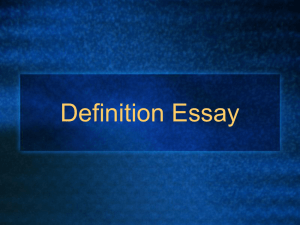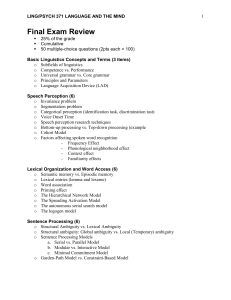Clear Thinking, Critical Thinking, and Clear Writing
advertisement
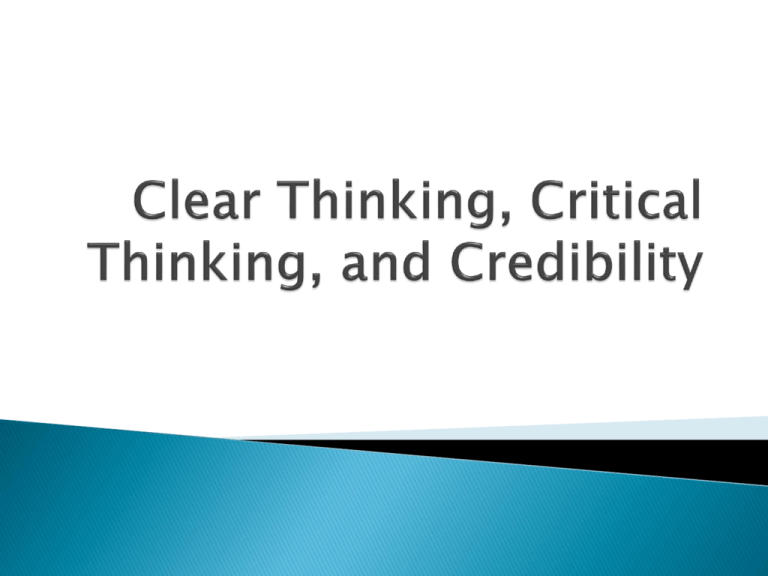
A definition states the meaning of a word. The word being defined is the definiendum and the definition is the definiens. Numerous types of definitions exist, and defining a word can mean a variety of things. Are definitions a help or a hindrance in understanding our world? One school of thought maintains that by defining things we separate then into discrete parts when in fact the world is continuous, a seamless cloth. The idea is that when we define an object we artificially snip off pieces from the endlessness of reality in order to make it manageable, but something of the object’s essence becomes lost when we try to harness it by forcing it into the limits of a definition. However, we do know that to think without language is extremely difficult, but with a set of defined words we can conceive and imagine things almost without limits. Overall, definitions enrich our understanding. Lexical definitions – in this kind of definition a description is offered of the conventional meaning of a word, and if the description does not match the actual way that the word is used, then the definition is incorrect. Depending on the accuracy of the survey of the usage, the definition is either true or false. A lexical definition gives an explanation of the general meaning a word carries for a group of language users. Stipulative definitions - to introduce unusual or unfamiliar words, to coin new words, or to introduce a new meaning to a familiar word. Stipulative definitions come in two varieties, arbitrary and precising. In the arbitrary type people stipulate that, for their purposes, an invented word will henceforth carry a particular meaning. ◦ For example, Sigmund Freud invented three terms to stand for the fundamental energy systems of the psyche: The “id” represents primal upsurging desires; the “ego” means control by rationality and realism; and the “superego” means the internalized social rules, manifested chiefly in the form of conscience. In the category of arbitrary stipulative definitions are also acronyms, or words formed from the initial letters of a phrase. We speak, for example, of “NASA,” National Aeronautics and Space Administration or “NASCAR,” National Association of Stock Car Auto Racing. Many words begin as acronyms, and if they become assimilated into the culture, the original words that made them up are lost. The second type of stipulative definition is a precising one whereby a person proposes to use an ordinary word in a special, limited, or precise sense. For example, a legislator may say, “My bill proposes aid for the poor, and by ‘poor’ I mean those with family incomes below $6,000 per year.” Since all stipulative definitions are forewarnings and statements of intent, we can never accuse them of being false; they are, after all, simply proposals. But we can criticize them for being illegitimate. That is, if someone offers a definition that we cannot accept psychologically, a definition that tries to persuade us to accept a peculiar point of view, then it can be criticized as unacceptable. ◦ For example, “Fork: an instrument used chiefly for putting dead animals into the mouth.” - Ambrose Bierce ◦ When I talk about the policy giving tax breaks to the middle class, I define middle class as ________. What does it mean to be in the middle class? Sometimes definitions are used for persuasive purposes and are charged with positive or negative emotions; in such cases they are considered loaded. A loaded definition has an “attitude”; it expresses a value judgment and is not just a neutral description of conventional meaning. Take the following examples of loaded definitions: “an intellectual is someone who knows everything except how to make money”; and “immigrant” is “an unenlightened person who thinks one country is better than another.” These definitions are funny, but should be avoided when we are seriously discussing issues. Example definitions explain the meaning of a word by mentioning some instances of it. In terms of our discussion of extension, they explain a meaning by pointing out some of the members of the class. Once we know the range of things referred to by a term (assuming it is referential), then we have a clearer understanding of its meaning. For instance, an example definition of “bird” might include Robin, Oriole, Blue jay, and so forth. Also covered by example definition are descriptions of the sort of experience that is involved. For example, we might explain the meaning of “depressed” as the feeling you get when you’re alone after breaking up with someone you’ve been involved with for a long time. It’s Saturday night, the telephone doesn’t ring, no one knocks on the door, there’s a party next door, and a blues song is playing on the radio. That is being depressed. We might define “trusting” as disclosing personal secrets, allowing oneself to be vulnerable. Sometimes a description of the experience or a catalog of examples is not enough of an explanation, and we can only show the object, event, or characteristics to which a word applies. We have an ostensive definition. For instance, the best way to explain “red” is to hold up different red objects. To explain “spicy” we might have them taste a spicy food. Some things are first hand experiences, and no description of characteristics will convey the meaning adequately. A person blind from birth will never understand the word “red” except in the descriptive sense. Synonyms constitute another type of definition, and here another word is offered that has approximately the same meaning as the first. For example, to define honesty we could list truthfulness, frankness or candor; for humorous we could list funny, comical, or amusing. Of course, the synonym must be a word that is understood, otherwise the meaning of the original word will not be clarified. Thus the effectiveness of a synonym definition depends on the reader’s stock in trade; the larger his or her vocabulary, the more effective the synonym is likely to be in explaining the meaning of a word. In forming sound definitions, whether stipulative, lexical, synonym, or example, certain standards must be met. These standards make the definition reliable, keep it honest. Some standards have already been discussed: that stipulative definitions must be psychologically acceptable and that lexical definitions must reflect conventional usage. However, there are additional criteria for acceptable definitions, and they are usually listed as pitfalls to avoid. Definitions should not be circular. A circular definition usually repeats the defined word in the definition. To define “cookbook” as “a book used to cook” is not very informative. A definitions is also circular when it defines two words in terms of each other. For example, “A cause is that which produces an effect” and “An effect is that which results from a cause.” These definitions are just going around in circles. Another trap to avoid is having definitions that are too broad or too narrow. If our definition is unduly broad it will cover too much, failing to rule out things that are extraneous. If it is too narrow it will cover too little, excluding things that should be included within the term. For example, if I think that behaving politely means not burping at the dinner table then my notion of what it means to behave politely might be too narrow. On the other hand, to define “music” simply as sound would qualify the noise of jackhammers, sirens, and traffic as different kinds of music. Metaphorical definitions should be avoided. In poetic discourse metaphors and similes, images and symbols, are the life blood of the art, but in formulating definitions, where clarity and directness are critical, such language should be avoided. It is unilluminating to define a “saint” as “a dead sinner, revised and edited,” or “happiness” as “a warm puppy.” To those familiar with these terms, the coloring adds interest, but it will not help anyone who is ignorant of the principle meaning. Such definitions might even mislead people, especially those learning English as a second language. Sometimes definitions are used for persuasive purposes and are charged with positive or negative emotions; in such cases they are considered loaded. A loaded definition has an “attitude”; it expresses a value judgment and is not just a neutral description of conventional meaning. Take the following examples of loaded definitions: “an intellectual is someone who knows everything except how to make money”; and “immigrant” is “an unenlightened person who thinks one country is better than another.” These definitions are funny, but should be avoided when we are seriously discussing issues. Providing good definitions may seem a trivial matter, but we need to be conscientious about them because they may be the basis of important decisions. For instance, it is crucial to determine the meaning of “person” in the abortion controversy. If someone is arrested for sale or possession of drugs the definitions of “narcotic” and “controlled substance” are crucial. Vague words or expressions lack clarity and distinctness, so that we don’t know whether they apply in a given case. The limits of their application are fuzzy, and we are uncertain about what they include and exclude. Almost all words are vague to some extent, and in most cases this does not interfere with their meaning. Language is labeled vague only when it is unnecessarily imprecise, when the intension does not allow us to identify the extension. Then we criticize usage and vagueness becomes a charge. For example, suppose we ask a used car salesperson how much a car costs and we are told it’s a bargain, a very good deal, less expensive than we might think, priced to move, sure to save us money, and so forth. Because the car salesperson is not giving us a price, he or she is probably trying to make us think that that the car is cheaper than it really is; the vagueness is deliberate and meant to trick us. On the other hand, the question “How much do you love me?” cannot be answered in numbers. Replies such as “as much as you deserve” or “not wisely but too well” are perfectly appropriate. If we want to measure how happy a person is, we are demanding what Aristotle called greater exactitude than the subject matter will allow. Vagueness is not always negative. ◦ “You must not know too much, or be too precise or scientific about birds and trees and flowers and watercraft; a certain free margin, and even vagueness – perhaps ignorance, credulity – helps your enjoyment of these things.” – Walt Whitman In some contexts, of course, it becomes extremely important to reduce the vagueness of words as much as possible. If food stamps are offered to the poor, defining who exactly is “poor” can make a significant difference in people’s lives. In ambiguity a word contains several meanings, and we are uncertain which one is meant. We are confused about the word, phrase, sentence, or passage because it can be understood in more than one sense. One traditional distinction that is made among types of ambiguity is between semantic and syntactic forms. Semantic ambiguity has to do with the multiple meanings of a word as it appears in a sentence, either once or twice. To take a couple of light examples, “Our druggists dispense with accuracy; “Bikinis now sold for a ridiculous figure.” Semantic ambiguity can be more serious, though. The Second Amendment to the Constitution states, “ a wellregulated militia being necessary to the security of a free state, the right of the people to keep and bear arms shall not be infringed.” Does this mean that only “militia” such as the National Guard are allowed to have arms, or that every citizen has the right to own a gun ( and all gun control laws are unconstitutional)? Serious debate has occurred as different people interpret the Second Amendment in different ways. Syntactic ambiguity applies to a complex expression when it has more than one meaning because there is more than one way to understand its grammatical structure. We are going to discuss sex on TV. If you think are waitresses are rude, you should see our manager. Under the broad category of semantic ambiguity the phenomenon of accent should be mentioned. Here ambiguity occurs because it is unclear which word in a sentence is being accented or emphasized. A defense lawyer once asked a coroner, “How many autopsies have you performed on dead bodies?” He replied, “All of my autopsies were on dead bodies.” The attorney wanted to know the number of autopsies that had been performed, and the coroner assumed that he was asking whether all of his autopsies had been done on corpses. The misunderstanding occurred because different parts of the question were stressed. Read the following definitions and identify the mistake, whether circular, too broad, too narrow, metaphorical, or rhetorical/loaded. Torture is “any act by which severe pain and suffering, whether physical or mental, is intentionally inflicted on a person for such purposes as obtaining from him or a third person information or a confession. – U.N. Convention against Torture, 1984 Too narrow. Torture is not always inflicted in order to obtain information or a confession. Read the following definitions and identify the mistake, whether circular, too broad, too narrow, metaphorical, or rhetorical/loaded. A lion is a feline. This definition is too broad because it would include tigers and panthers and so forth. Let’s have a friendly contest. How many commercial messages does the average person see a day? How many do they see by the time they are 25 years old? The typical person sees 250 commercial messages daily and more than two million of them by the time he or she is twenty-five years old. Studying advertising and the strategies used by advertisers helps us to become more critical, insightful, and selective consumers. When it comes to commercial ads, for the most part, skepticism is a virtue. In broad terms, advertising uses promotional techniques to persuade people to purchase products or services. The American Marketing Association’s definition is “any paid form of nonpersonal presentation and promotion of ideas, goods, or services by an identified sponsor.” 1. 2. 3. 4. 5. 6. 7. Toasters, lipstick, cologne, etc… Candidates – some ads try to convince us to vote for a certain candidate. Help other people Give up a bad habit Join the army Talk to your kids Eat at the dinner table 1. 2. 3. Well trained psychologists. Creative artists Spends lots of money to learn our psychological weaknesses, our motivations, etc… College students usually say that advertising does not influence their decisions. However, studies show that ads can increase sales of certain products. Most Americans see ads as something thing they can easily tune in and out. Advertisers want us to believe that. They want to subtly influence us. The majority of things we buy- toothpaste, toothbrushes, and so forth are pretty much the same. They share the same marketing techniques, manufacturing techniques, and use the same technology. The only difference may be how it is presented. Can we trust the news? Moore and Parker book…. How do news stations get their news? Press releases from government institutions and businesses, research is expensive. Is the media biased? How many people think so? List reasons why this claim is true. If you don’t believe this claim is true, then why do some people think it is true? In the mid twentieth century, there were thousands of media outlets. Since 2001, the Federal Communications Commission loosened the regulations regarding ownership of newspapers, radio stations and television stations. There were 50 independent companies by 1983. By late 2004, the majority of all media companies in the United States were controlled by just five companies. In the United States, five huge conglomerates control the vast majority of media in the United States: Time Warner, Disney, News Corp, Bertlesmann, and Viacom. G.E. is a close 6th place. Together, they own about 90% of the media. What do you think are the pros and cons of a handful of corporations owning most of the main media outlets? Examples of government management of the news: ◦ In 2007, FEMA held a press conference. However, no reporters were present. Instead, FEMA staff members sat in the audience and asked questions. ◦ In 2005, syndicated columnist Michael McManus was paid $10,000 by the Department of Health and Human services for writing about one of the government’s Marriage Initiative programs. The title of his column happened to be entitled “Ethics and Religion.” ◦ How independent were the independent military analysts on some of the major news stations? http://www.nytimes.com/2008/04/20/washington/2 0generals.html?_r=2&hp=&oref=slogin&pagewanted= all The US military has banned the American media of taking pictures of caskets returning from war since 1991. Some journalists ask what that has to do with national security. What do you think? Is it proper for the government to manage the news in this way?
